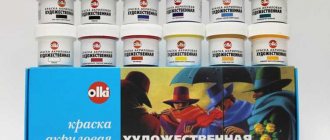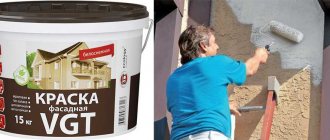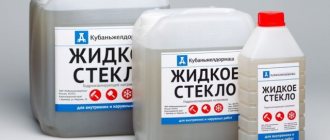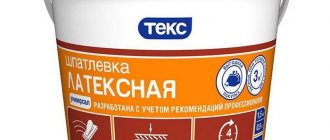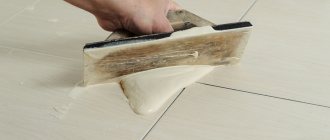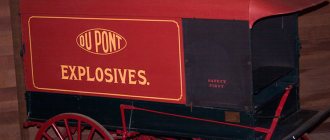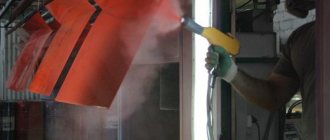Recently, more and more often, when renovating a room, people prefer acrylic paint, the very first and logical question that arises is how long does acrylic paint dry? After all, you need to know exactly when to apply the next layer in order not to harm the work.
Very often people limit themselves to a quick glance at the instructions indicated on the package, but this is wrong. It would be better to study the main points in order to avoid unforeseen situations, since a huge number of factors can affect the drying time of the composition.
Features of acrylic composition
The composition is made using three main components: color pigments, water, acrylic. It has a wide range of colors, so there are no problems with choosing the right shades, it has shine and light fastness. Unlike oil paints, acrylic dries much faster, which makes it a deservedly popular material when used in decoupage, art, painting and for decorative purposes.
The substance is waterproof, quick-drying and practically non-toxic; these properties allow it to be used when working with children. Drying time largely depends on the thickness of the layer of material applied and the coating being painted.
Due to the fact that the composition dries quickly, its use will not create any problems. On the contrary, certain methods are often used to slow down the drying of the solution. This is sometimes required to achieve a better effect.
General recommendations
- First, you need to study in detail the information on the manufacturer's label. Close attention should be paid to the shelf life of the product and its intended purpose.
- As a rule, the packaging indicates the method of use, how long the material takes to dry, on what surfaces it is used and the approximate consumption of the substance. For example, information about the length of time it takes for aerosol in cans to dry can be found in the instructions on the back of the can itself.
- It is not recommended to dissolve dried paints with thinners, as you will not achieve a positive result.
- It is necessary to understand that not all solutions are completely universal. Depending on the surface of the material on which you plan to paint, there are certain differences. For effective work, compositions for special purposes are selected.
- The coating on which the solution is applied also significantly influences the time required to complete drying. Bases with smooth and non-absorbent surfaces, such as glass, iron, and plastic, take the longest to dry. This is characterized by the fact that the drying process is influenced exclusively by the natural evaporation of liquid.
Paper, canvas, wood, foam plastic, cardboard have a porous structure, which helps to significantly reduce drying time.
How to choose acrylic?
- The composition must include a special hardener. It is needed to quickly start a chemical reaction, which is very important for polymerization.
- It is not recommended to use bottles that have expired.
- Pay attention to the volume of the container: if a small amount of solution is needed to complete the job, you should not buy a large jar. It will dry out quickly.
- The composition is non-toxic, practically odorless, so it can be used in a residential area and is harmless to children or pets.
IMPORTANT! Before purchasing a product, it is recommended to find out in detail from a sales consultant what the compositions are. As a rule, they differ in the basic base - water-dispersed or organic. For external work, organic-based solutions are suitable, but for interior painting of walls and ceilings they are used on a water-dispersion basis.
Examples of using
Acrylic is used everywhere. It adheres well to any surface, with the exception of a few types of plastic. Moreover, the composition is applied to the plane in various ways. From brush and roller to spray can and spray.
The composition can be used in any living space, even a children's room. Since dried paint is not afraid of water, it is excellent for bathrooms and bathrooms. An interior or decorative look is chosen for these purposes.
Painting walls using a roller Source brilias.com
Paint the door with acrylic spray paint Source kraski-net.ru
But the façade palette is also widely used. It helps protect concrete and metal structures outdoors from the elements. This is especially important if there are parts that are susceptible to corrosion. The use of the composition on wood protects it from pests and moisture.
If the house has floors with a concrete or wooden surface, then the composition should be applied in at least two layers. First the surface is primed and then painted. And you don't have to worry about how long it takes for floor paint to dry. In most cases, the work can be completed the next day.
Since a special wear-resistant composition is produced for the floor, the surface will last up to 10 years without repair. And the next day you can safely wash it with water. Moreover, you can paint not only in interior spaces. The mixture holds up well on outdoor areas. The truth loses its properties a little faster.
Painting curbs on the street with acrylic paint Source change.org
Another popular application is painting the bathroom. Moreover, not only the walls are often covered, but also the ceiling in the room. Moreover, the applied composition looks on the surface like a thin layer of plastic. And special components in the mixture do not allow mold to develop.
The main advantages of acrylic paints
Acrylic compositions are widely used; they are used both during interior decoration and for decorating various surfaces. The main advantage of paints is that they can be applied to almost any type of surface. In addition, they are very easy to use; you don’t have to be a professional to paint a room with high quality; thanks to their structure, even a beginner can cope with this task.
These paints are very often used when creating works related to hobbies (painting on ceramics, glass, etc.). You can paint stained glass windows or stone with paint.
They have the following advantages:
- they can be used on different surfaces;
- huge range of colors, tinting available;
- hardens and dries very quickly;
- do not have a strong odor;
- high adhesion rate (adhesion, adhesion to the surface);
- They are quite resistant to the environment, and therefore they can be used even in rooms where air humidity is high;
- you can create smooth and textured coatings;
- they are very durable and retain their color and shine for a long time;
- fresh stains can be easily and quickly cleaned off;
- can be combined with other paints;
- high-quality hiding power, allows you to save material consumption;
- can be used for both exterior and interior decoration;
- they are very easy to apply;
- resistant to abrasion, ultraviolet radiation, and various solvents;
- have low toxicity;
- are resistant to various temperature changes.
Airflow speed
If all the windows and doors in a room are closed, there is no movement of air masses in it. Therefore, all fumes from the paint collect in a cloud above the surface. And this already means an increase in humidity. What happens in this case has already been described.
Creation of forced ventilation Source pixel-shot.com
It is necessary to establish good air circulation in the room. So that any moisture that comes out of the paint is immediately blown away. It should be noted that in any well-ventilated room the humidity drops significantly.
Acrylic paint drying time
When drying, the acrylic composition goes through certain stages, regardless of the application method. If liquid acrylic was used when painting, then it will take much longer for complete drying, since this is required by the thinners that are used.
Stage 1 – “Evaporation”
This is liquid acrylic itself, which evaporates during application to the surface. Once in the atmosphere, solvents and water leave the paint; this is the first stage of drying. For liquid formulations, this stage may take several days.
Stage 2 – “Film Formation”
After the light volatile substances evaporate, the paint begins to form a film. In those places where the acrylic is laid down thinly, the film will appear faster, and where the film is laid down in a thicker layer, its formation will take up to 8 hours.
Stage 3 – “Drying without sticking”
At the next stage of drying, you can check the dryness of the surface by applying your fingers; if the paint has dried completely, then touching it will not spoil the painting. Usually this stage occurs after 24 hours.
Stage 4 – “Deceptive State”
At this stage, it seems that the paint is completely ready for the application of the next layers, epoxy resin or varnish, but this is not entirely true. Although the paint looks dry on the outside, the inner layers are not yet fully formed and applying different compounds to them can lead to paint peeling or smearing. Typically it takes 48 hours to complete this stage.
Stage 5 – “Complete drying”
At the last stage of drying, the acrylic completely hardens. As a rule, all volatile substances and evaporators are completely evaporated at this stage and the coating is ready for the next application of varnish, additional layers of solution or epoxy. Acrylic paint may release small amounts of volatiles for several weeks. The last stage takes 72 hours.
How long does it take for different types of spray paint to dry on metal?
Coloring sprays are composed of:
- Acrylic . These formulations do not tolerate heat from a hairdryer to speed up drying. And with a sudden increase in temperature after their application, they can peel off. If the finished composition from the manufacturer is diluted with water, this prolongs the drying time. On average, the contents of acrylic cans dry on metal for at least 40 minutes. Maximum time – 3 hours. Acceleration occurs with a larger amount of acrylic resins in the composition.
- Alkyd aerosols . They are distinguished by exceptional resistance to atmospheric surprises, durability, elasticity and record-breaking short drying time. From spraying from a can until the paint is completely dry, it takes 10-15 minutes.
- Nitrocellulose enamels . For natural drying, they require heat from +22. If the metal is coated in several layers, their drying time is distributed as follows:
- The first layer is ready in 25 minutes.
- The second one takes 6-7 hours to dry.
- The third one will take a day.
When the last layer is going to be polished, the metal product has to wait 7 days for it to be ready.
Varnishes in cans
Often, an additional varnish is applied over the paint, which acts as a protective and at the same time decorative coating. But then you have to wait longer for the surface to dry. Modern aerosol varnishes can give a product a 3D effect or a fashionable gloss.
But before spraying the varnish coating, you must wait until all previous layers of paint have completely dried. The process is accelerated by heating the varnish spray and spraying it onto the heated metal surface. The exception is varnishing enamel with a metallic effect. Here drying should only be natural.
Factors affecting drying speed
How quickly acrylic paint dries is influenced by a number of factors - air humidity, temperature, flow. Depending on the combination of these factors, the rate of evaporation of water and solvents will change.
Temperature
The ideal temperature for proper drying is 18-24 degrees with a humidity not exceeding 50%. If the room temperature is below 10 degrees, then the paint will not be able to dry, and at 0 degrees the water in the solution will freeze. If the air temperature is above 24 degrees, then the upper layers will dry out earlier than the lower ones and this can lead to cracking.
Air humidity
This factor also affects the drying speed, since during drying a large process of evaporation of water and solvent occurs. If the air in the room is very humid, then the evaporation process will be delayed, since there will be little room in the air for additional moisture. And if the room humidity is very low, then the evaporation process will happen faster, since there will be enough space in the air for additional moisture.
Air flow
For faster drying, an active air flow is required, since during drying a large amount of water evaporation accumulates on the coating, which slows down the process of complete drying. If the room is ventilated, then the flow of fresh air will dilute the cloud of vapors, thereby reducing the humidity and speeding up the drying process.
Atmosphere pressure
Another factor influencing the process of how long acrylic paint dries is pressure, since pressure can make molecules move faster, and the faster the molecules move, the faster the evaporation process will take place.
Base surface
Depending on what surface the acrylic paint is applied to, it will be clear how long the acrylic will take to dry. For example, wood and HDF are not able to absorb water and solvents, so paint on them will take longer to dry. If the paint is applied to canvas, paper, fabric, then the drying process will take less time, since these surfaces absorb water.
Temperature
Uninformed people have a strong belief - the hotter it is indoors or outdoors, the faster the drying processes occur. This is partly true, since already at +24°C the top layer of paint quickly turns into a crust. But underneath there remains an undried mixture.
It turns out that the applied paint is divided into two levels. The upper one has already dried, and the process of moisture evaporation continues in the lower one. True, she has nowhere to go, because there is no longer a passage. But the force of the couple is still enough to break through the dried layer and come out. In this case, cracks form on the surface, and the work is considered damaged.
A layer of acrylic paint that has burst due to improper drying Source auto.orsk.ru
Processes proceed completely differently when there is not enough heat. When the temperature drops below +10°C, the evaporation of moisture stops, and it begins to intensively crystallize. In this case, the layer may collapse, and the procedure itself will be delayed for a long time.
Therefore, the optimal temperature for intense steam release is considered to be between 18 and 20 degrees Celsius above zero.
What can I do to make the composition dry longer?
Sometimes situations happen when acrylic dries very quickly and this leads to cracking.
In order to slow down the drying of the paint, you can resort to the following methods:
- it is necessary to reduce the air temperature in the room, but maintain the recommended temperature;
- increase the air humidity, this can be done with various humidifiers, or bring a bucket of water into the room and put one end of a rag in it, the main thing is not to overdo it, since the air humidity should not be higher than 75 percent;
- avoid drafts in the room so that air movement is minimized;
- add a retarder that prevents drying, retarders are mainly made on the basis of glycerin, they slow down the rate of passage of water and solvent through the paint and this increases the drying time;
- apply the paint in a thicker layer, but you should not make a layer that will be thicker than 3 mm.
How to speed up drying
In optimal microclimate conditions, paint dries best, forming a strong and durable film. There are several ways to speed up drying:
- do not use water for dilution, but only a special drying accelerator;
- turn on artificial heating to increase the air temperature to +25 °C;
- organize ventilation in the room or turn on forced air ventilation.
The paint dries faster if you do not dilute it with plain water and dry it with a hairdryer at the same time. Small areas can be dried with a regular hair dryer. If the painted area is large, you will need a hair dryer. In painting, accelerating drying is rarely used; on the contrary, a component that slows down drying can be added to the dye to achieve the desired result.
Useful tips for working with acrylic
IMPORTANT! When tinting the composition and mixing different colors, it should be remembered that after the liquid has completely evaporated, the color of the surface becomes slightly darker and more saturated.
Thinning the material
The substance must be diluted moderately. If you add more than 20% water, the adhesion (adhesion, sticking) of the material decreases, which can cause peeling of the treated coating after drying.
After painting with a solution diluted with water, the layer becomes translucent, through which the base or previously applied ornament can be seen. This makes it possible to obtain very smooth transitions and other interesting effects.
To reduce the viscosity of the composition without losing the color intensity, water can be replaced with a special diluent.
How to use?
To form an even coating, the walls and ceiling should be puttied and sanded with fine sandpaper in advance.
You can hide minor polishing imperfections using a matte composition. It is highly not recommended to apply it over oil- or alkyd-based layers, but it fits perfectly on water-based and latex bases.
Before work, the base is first cleaned of dust and greasy traces.
How to coat and degrease the base:
- the technical characteristics of white spirit allow you to work with fiberboard, chipboard, metal, but you can also use solvent 646;
- ethyl alcohol is suitable for leather, plastic, stone, glass;
- specialized products - for any coatings, except for certain types of plastic;
- various types of primers intended for walls and ceilings.
To eliminate spreading and uneven absorption of the water-polymer dispersion during operation, it is recommended to first treat the base with high absorbency with primer. On smooth surfaces (metal, plastic, glass) the composition is applied only after preliminary priming, since the coating may not adhere well due to poor adhesion.
What's the most effective way to remove interior paint?
This does not require a lot of work, the recipe is very simple: if it is an ordinary color emulsion, then it can be removed with a wet sponge and soap solution.
When dry, you can pry it off with a spatula.
But, if it is washable latex-based paint, it can only be washed off with chemicals.
Water-based paints are the best among coloring agents.
- Due to the high density, cracks up to 2 mm can be painted over;
- They have a good color palette;
- Do not pose a chemical hazard;
- Acrylic paints have a washable base;
- They do not smell as strong as oil ones;
- The network of water-based emulsion production is widely established.
”
Variety of palettes
Acrylic is known for not being able to dissolve once completely dry. None of the known materials helps in resolving the issue. Therefore, you should not use the composition in conjunction with porous structures on which any other paint adheres well. Wood, even with a good varnish coating, will also be a bad choice. Glass doesn't work either.
Don't forget about additional recommendations:
- The surface must be clean and free of grease before being treated with acrylic paints. This applies even to completely new products and materials.
- Acrylic paints generally penetrate well into any type of structure. This means that it is better to pre-coat the surface with a primer. Then the result will be noticeably better.
- One of the main advantages of acrylic paints is the ability to choose absolutely any color; the available palette is truly rich. The main thing is to remember the ability of open air to increase drying time. This is especially important for those doing mixing or if glass is used.
Paints that have been thinned before starting work take longer to dry. At the same time, there is still no universal parameter; you must carefully study the instructions every time. It helps to study the accompanying documentation, which should also be attached to the compositions. It doesn’t matter what kind of packaging is used in a particular case.
More about acrylic paints (2 videos)
Acrylic-based wall paint (25 photos)
Different ways to dry paint quickly
Not a single renovation has ever been completed without the use of paint.
It doesn’t matter whether you carry out construction work indoors or outdoors
Everyone is interested in the question of how to quickly dry paint, because you either don’t have enough time, or you want to finish the repair in a short time.
Then you need to know the characteristics of the paint you are using, and listen to the advice of experienced craftsmen, learn a little from their experience of working with materials.
Experts identify several ways to quickly dry paint.
On the market among construction products you can find no more than four groups of paints:
- Oil and alkyd.
- Water-soluble, water-emulsion, water-dispersed.
- Specialty products regardless of the basis.
- For decorative coating.
Paints that dissolve with water can be used for external and internal work and can be used to treat concrete, brick, and plaster surfaces.
Their advantage is environmental friendliness, because they do not contain organic solvents, and such a surface will allow air to pass through, since a vapor-proof film will not form.
This group of paints is produced on the basis of polyvinyl acetate, styrene butadiene and acrylic dispersions.
Oil dyes are also used indoors and outdoors; they paint and protect wood and metal. They form a strong vapor-proof film on the painted material, that is, it is fire and toxic.
There are four types of paints in total
Special coloring agents have been developed to protect wood from fungi and mold and those that impart water-repellent properties to the surface.
The decorative group serves to hide errors or small irregularities in the building material being painted.
Which paint dries faster?
We always use paint when we repair or re-build something, because we cannot do without painting surfaces. Almost all dyes have a characteristic, pronounced odor. And we all want to get rid of it as soon as possible.
And to achieve the desired result, you need to dry the paint quickly. If the paint is oil-based, you will have to work hard to make it dry quickly. The best way is to replace it with water-soluble or alkyd. It dries quickly and will not cause any inconvenience when using it.
Types and features of paints
On the market among construction products you can find no more than four groups of paints:
- Oil and alkyd.
- Water-soluble, water-emulsion, water-dispersed.
- Specialty products regardless of the basis.
- For decorative coating.
Paints that dissolve with water can be used for external and internal work and can be used to treat concrete, brick, and plaster surfaces. Their advantage is environmental friendliness, because they do not contain organic solvents, and such a surface will allow air to pass through, since a vapor-proof film will not form. This group of paints is produced on the basis of polyvinyl acetate, styrene butadiene and acrylic dispersions.
Oil dyes are also used indoors and outdoors; they paint and protect wood and metal. They form a strong vapor-proof film on the painted material, that is, it is fire and toxic.
Special coloring agents have been developed to protect wood from fungi and mold and those that impart water-repellent properties to the surface.
The decorative group serves to hide errors or small irregularities in the building material being painted.
Which paint dries faster?
We always use paint when we repair or re-build something, because we cannot do without painting surfaces. Almost all dyes have a characteristic, pronounced odor. And we all want to get rid of it as soon as possible. And to achieve the desired result, you need to dry the paint quickly. If the paint is oil-based, you will have to work hard to make it dry quickly. The best way is to replace it with water-soluble or alkyd. It dries quickly and will not cause any inconvenience when using it. Well, if this option is not suitable, you should find out all the ways to dry the paint.
Surface treatment
Applying water-based paint to drywall
These types of paint dry quite quickly.
Therefore, if you move the brush in one place for a very long time, the putty will begin to fall off.
A similar defect can occur due to poor putty or lack of primer.
Water-based paint is well absorbed into the surface due to its properties.
Of course this is very good.
Moreover, it contains an antiseptic.
The only downside is that the surface remains unpainted.
There is little joy in instant drying. Because this does not happen evenly.
Consequently, after drying it may appear in the form of streaks and stains. Consequently, you will have to paint several more layers on top to hide the resulting defect.
Another interesting question is how long it takes for water-based paint to dry on drywall. Here it will dry instantly, simply because it will be absorbed immediately.
To ensure that the paint remains on the surface immediately, it is better to carry out preliminary preparation. This can be done with putty or primer.
Of course, this is a personal matter for everyone. Just remember that in the absence of a primer, the paint itself will play its role. If it is liquid and the surface is porous, it is impossible to guess how many layers will be needed.
Therefore, it is better not to try to save money in this matter. It will be more expensive. In addition, painting will take much more time. Layers of this paint should absolutely not be applied at once.
This can cause the under-dried layers to stick together and begin to fall off in pieces. After this, they will have to be cleaned completely. And therefore paint again.
In the video you can see how to paint a ceiling with water-based paint:
How does the material harden?
Acrylic paint initially contains a hardener, due to which the polymerization reaction is activated when the composition is applied to the surface. The material of manufacture in this case does not matter. Ambient temperature is the main catalyst that initiates the reaction. The higher the temperature, the less time it takes to dry completely.
When performing work inside and outside, it is often possible to achieve surface heating of up to 25 degrees, or even higher. This certainly does not lead to instant drying of the material. Drying time increases. It is better to use special equipment if possible.
On video: what is acrylic paint?
